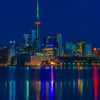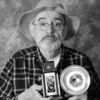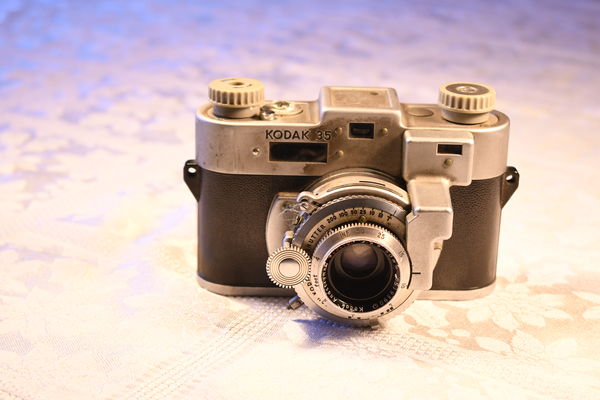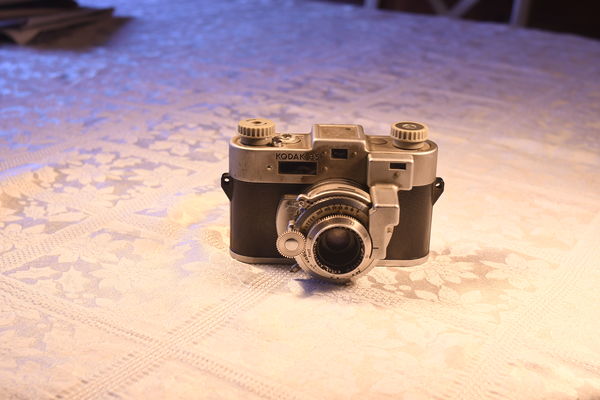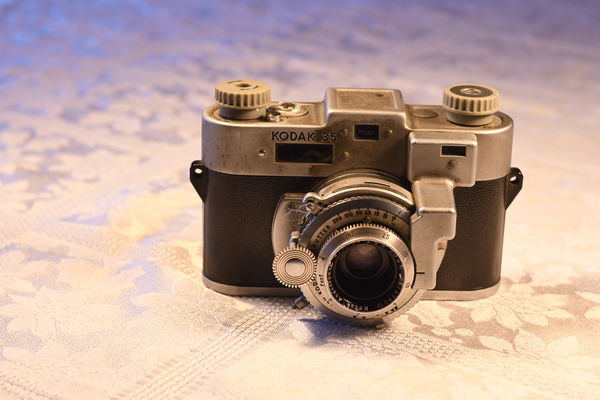Use Film SLR Lens on DSLR
Jan 22, 2018 15:57:27 #
RWR
Loc: La Mesa, CA
Screamin Scott wrote:
Best to refer to the chart I linked to...
The user’s manual is pretty good, too. Not only says what can be used, but what functions are or not useable. It’s even recommended at the bottom of the chart.
Jan 22, 2018 17:30:24 #
was_a_guru wrote:
I have a Nikon DSLR with two kit lenses (18-55 f/3... (show quote)
Not sure about Nikons, but I use Olympus/Zuiko lenses on my Canon, with an adapter. Strictly manual focus, I can still use aperture priority and manual of course.
Jan 23, 2018 07:18:55 #
was_a_guru wrote:
I have a Nikon DSLR with two kit lenses (18-55 f/3... (show quote)
A lens is a piece of photographic equipment that captures light and casts it on a flat area behind it. It does not know whether you’re using film or a digital sensor. There is no such thing as a “film lens”. Any Nikkor lens with an F mount and an AI or better specification can be used on a digital body. Older lenses were not AF so you’ll have to focus manually. D3xxx and D5xxx bodies will not meter older lenses.
Jan 23, 2018 09:50:14 #
was_a_guru wrote:
I have a Nikon DSLR with two kit lenses (18-55 f/3... (show quote)
I have a large assortment of film lenses that I use on a regular basis on my D700 and my D810. Both cameras have internal motors so i am able to focus in a non manual mode.
Rick
Jan 23, 2018 10:19:46 #
was_a_guru wrote:
I have a Nikon DSLR with two kit lenses (18-55 f/3... (show quote)
I have a Nikkor 50mm f1.4Ais, and a Spiratone 28mm f2.8 that I use on my D80 and D610. You have to shoot in M, adjust the aperture on the lens, and the shutter speed on the camera. Metering through the camera is tricky, so I usually use the Sunny F16 rule. Good luck, I have captured some interesting images that way
Jan 23, 2018 12:26:40 #
amfoto1
Loc: San Jose, Calif. USA
was_a_guru wrote:
I have a Nikon DSLR with two kit lenses (18-55 f/3... (show quote)
You didn't specify what Nikon DSLR or the exact Series E lenses you have... They may or may not work, depending upon the camera.
Manual focus lenses... no problem. Old autofocus lenses, on the other hand, won't be able to autofocus on a D3000 or D5000 series DSLR. They might be able to autofocus on a D7000 series or D200/300/500. Other, earlier DSLRs... well you'll have to look them up on the compatibility charts (see below).
But there also may be exposure problems.... If the lenses don't have a manual aperture control ring (some Series E don't, if I recall correctly), there may be no means of setting the aperture.
Or... there may be metering issues, trying to use some lenses on certain models.
Compatibility charts and info...
https://www.nikonimgsupport.com/na/NSG_article?articleNo=000026574&configured=1&lang=en_SG
https://www.nikonusa.com/Images/Learn-Explore/Photography-Techniques/2011/Which-Nikkor-is-Right-for-You/Media/NIKKOR-lens-compatibility-chart.pdf
https://www.nikonians.org/reviews/nikon-slr-camera-and-lens-compatibility
http://www.kenrockwell.com/nikon/compatibility-lens.htm
Your math is backwards.... It's obvious from your question and confirmed by the kit lenses you got with it, that you have a "DX" camera with the smaller size sensor that "crops" images. The focal lengths of lenses really don't change... 18mm is still 18mm, 35mm is still 35mm and 50mm is still 50mm, etc. But any given focal length "behaves differently" when used on a crop sensor camera. A 35mm lens on a DX DSLR will "act like" a 54mm lens would have on your film camera. And a 50mm lens on a DX DSLR will "act like" a 75mm lens would have on your film SLR.
Both DX (crop) and FX (full frame) design lenses are fully usable on DX cameras (subject to the compatibility limitations mentioned above). FX cameras basically require FX lenses, even though most (all?) Nikon FX cameras can be fitted with a DX lens and will work in a limited way. In most cases it makes no sense to do so because in many cases the resulting "cropping" the FX camera will do to the images ends up much lower resolution than most of the modern DX cameras. For example, most current Nikon DX cameras are 24MP. Some of the FX models, such as the D750, as also 24MP but with the larger "full frame" sensor... Using an FX lens, you get full benefit of that 24MP camera. But if used with a DX lens, the D750's images will end up reduced to a little less than 10MP. Close to 60% of the FX sensor area is cropped away!
But it appears you have a DX camera, so the opposite is happening and you can full utilize both FX/film and DX lenses on it. The way the focal length "behaves" will be different... less wide, more telephoto. This is good for telephotos... but not great for wide angle. Your 18-55mm only goes "moderately wide", the equivalent of approx. 27mm on full frame/FX. Hence the need for an popularity of exceptionally wide (ultra wide) DX lenses. Nikon makes three of those.... 10-24mm DX, 12-24mm DX and a relatively new "budget priced" 10-18mm DX. There are also Sigma, Tokina, Tamron and other third party manufactured ultrawides.
Hope this helps!
Jan 23, 2018 12:44:40 #
amfoto1 wrote:
You didn't specify what Nikon DSLR or the exact Se... (show quote)
The OP said he has the 35mm f/2.5 Series E and 50mm f/1.8 series E and the D7500.
Jan 23, 2018 12:50:43 #
amfoto1
Loc: San Jose, Calif. USA
Fotomacher wrote:
...There is no such thing as a “film lens”. Any Nikkor lens with an F mount and an AI or better specification can be used on a digital body...
But there is such a thing as a "digital lens"....
Lenses designed for digital have improved anti-reflective coatings and some (especially wide angle) use re-designed optics that do a better job illuminating the edges and corners of the image area. Some are specifically designed to meet other needs presented by digital cameras, such as "ultrawide" designs that have become popular due to the prevalence of APS-C (DX, etc.) size sensors in digital.
And while they "can be used", it may or may not be very much fun to do so! Compatibility issues may make it impractical to use some older "film" lenses on a modern DSLRs (depending upon the particular lens and the specific camera). See the compatibility charts at the link above.
Nikon kept the F-mount from 1959 to present.... but had to do adaptations and modifications to it to accommodate new technologies such as through-the-lens metering, auto exposure, auto focus (several different types), image stabilization and probably more that I'm forgetting. While they can be applauded for making the effort to retain backward compatibility, the result is that there are all sorts of possible "issues" between cameras and lenses of different eras over those decades... hence the need for the compatibility charts!
Jan 23, 2018 12:52:22 #
Meaning he will have to manually focus & determine exposure since the camera will not meter with older manual focus lenses. He will also have to use manual mode on the camera & his EXIF info will not show any lens info. Kinda like when I used manual focus lenses on my old Nikon D70s
DTran wrote:
The OP said he has the 35mm f/2.5 Series E and 50mm f/1.8 series E and the D7500.
Jan 23, 2018 12:53:53 #
Screamin Scott wrote:
Meaning he will have to manually focus & determine exposure since the camera will not meter with older manual focus lenses. He will also have to use manual mode on the camera & his EXIF info will not show any lens info. Kinda like when I used manual focus lenses on my old Nikon D70s
Before I gave away my D70s I love using it with AI lenses. Manual focusing with no meter is nice.
Jan 23, 2018 13:56:28 #
RWR wrote:
The FX equivalent focal length of the 35mm lens will be about 54mm, that of the 50mm lens will be about 77mm on your DX camera. See your camera’s user’s manual under Compatible Lenses for using AI-s (Series E) lenses.
Correct! People get multiplication confused with division. And a factor is just a number. In this case 1.5; but you can use it as x1.5 or x(1/1.5) if you know what you are doing.
Jan 23, 2018 13:59:05 #
amfoto1
Loc: San Jose, Calif. USA
SHLeM52 wrote:
Not sure about Nikons, but I use Olympus/Zuiko lenses on my Canon, with an adapter. Strictly manual focus, I can still use aperture priority and manual of course.
That's a whole different thing.
Canon and Sony (Minolta at the time) basically abandoned their earlier, mechanically controlled lens mounts in the mid to late 1980s.... and converted to new mounts completely re-designed to accommodate the electronics they expected to be incorporated in the future. Minolta discontinued their SR-mount (and MC, MD versions of it), in favor of their new A-mount. And Canon dropped their FL/FD mount, replacing it with their EF-EOS bayonet. As a result, in both cases their earlier mount lenses are largely orphaned... and that made for a pretty tough transition at the time. But now 30 or more years later it's paid off because both Canon and Sony have built a whole new system with electronic lens-to-camera communication for autofocus, aperture control, image stabilization, distance data, and more... largely without any of the compatibility issues found in some of the other systems.
And, as a bonus, the larger diameter and lens register of the Canon and Sony mounts easily accommodate a wide variety of other system mount lenses via simple glassless adapters.... including Nikon F, Olympus OM, Pentax M42 screwmount, Pentax P/K bayonet, Leica R and more. Sony can even work with some other systems' autofocus lenses, via more expensive adapters (Canon can't).
In contrast, Nikon has some backward compatibility with Nikon.... Pentax has some with Pentax.... and for a while Olympus had some with Olympus. Each of them is more restricted to their own mounts, less able to accommodate other manufacturers'. (Note: Now all m4/3 mirrorless, Oly and their partner Panasonic can accommodate much of their own and many other mounts via adapters too... Plus even some vintage rangefinder lenses such as Leica M bayonet or 39mm screwmount.)
So, it's quite different.... Your modern Canon can utilize a lot of vintage lenses via inexpensive adapters that don't need image-ruining optics... But unfortunately not Canon's own vintage FL/FD. (More info here: http://bobatkins.com/photography/eosfaq/manual_focus_EOS.html)
On the other hand, modern Nikon - thanks to keeping essentially the same F-mount since 1959 - can accommodate many vintage Nikon mount lenses without need for any adapter at all (though there may be other compatibility issues)... But, even with adapters they cannot be used with very many other manufacturers' mounts.
Jan 23, 2018 14:05:27 #
Thankfully there are a plethora of older Nikkor & 3rd party Nikon mount lenses available and all of my Nikon DSLR's are able to use them with few limitations. I use my older Leica, Konica, Minolta, Canon & Pentax ( screw mount & bayonet mount) MF lenses on an Olympus mirrorless camera via mechanical adapters...
amfoto1 wrote:
That's a whole different thing. br br Canon and S... (show quote)
Jan 23, 2018 14:06:54 #
amfoto1 wrote:
In contrast, Nikon has some backward compatibility with Nikon.... Pentax has some with Pentax.... and for a while Olympus had some with Olympus.
Pentax has a very high level of compatibility with forty years of Pentax, and a simple ring-adapter makes m42 lenses compatible also.
Jan 23, 2018 14:12:30 #
So I experimented. With my camera on a tripod took three shots:
1. With my 18-55mm lens set at ~50mm, in A mode - f/5.6, 1/160, ISO 800
2. With the Series E 35mm lens, in M mode - manually set f/5.6, 1/160, camera set ISO 800
3. With the Series E 50mm lens, in M mode - manually set f/5.6, 1/160, camera set ISO 800
(#2 & 3 only worked in M mode.)
I had expected that since the Series E lenses were basically FX lenses that (based on the feedback on got here on my earlier question) the Prime 35mm lens would have an equivalent focal length of ~50mm and thus the object in the picture would be the same size as the one taken with the 18-55mm lens @ 50mm. But to my surprise it was 2/3 the size. The object size in the picture taken with the Prime 50mm lens was the same as the 18-55mm lens @ 50mm.
Now I am confused. See the attachments. ???
1. With my 18-55mm lens set at ~50mm, in A mode - f/5.6, 1/160, ISO 800
2. With the Series E 35mm lens, in M mode - manually set f/5.6, 1/160, camera set ISO 800
3. With the Series E 50mm lens, in M mode - manually set f/5.6, 1/160, camera set ISO 800
(#2 & 3 only worked in M mode.)
I had expected that since the Series E lenses were basically FX lenses that (based on the feedback on got here on my earlier question) the Prime 35mm lens would have an equivalent focal length of ~50mm and thus the object in the picture would be the same size as the one taken with the 18-55mm lens @ 50mm. But to my surprise it was 2/3 the size. The object size in the picture taken with the Prime 50mm lens was the same as the 18-55mm lens @ 50mm.
Now I am confused. See the attachments. ???
If you want to reply, then register here. Registration is free and your account is created instantly, so you can post right away.

